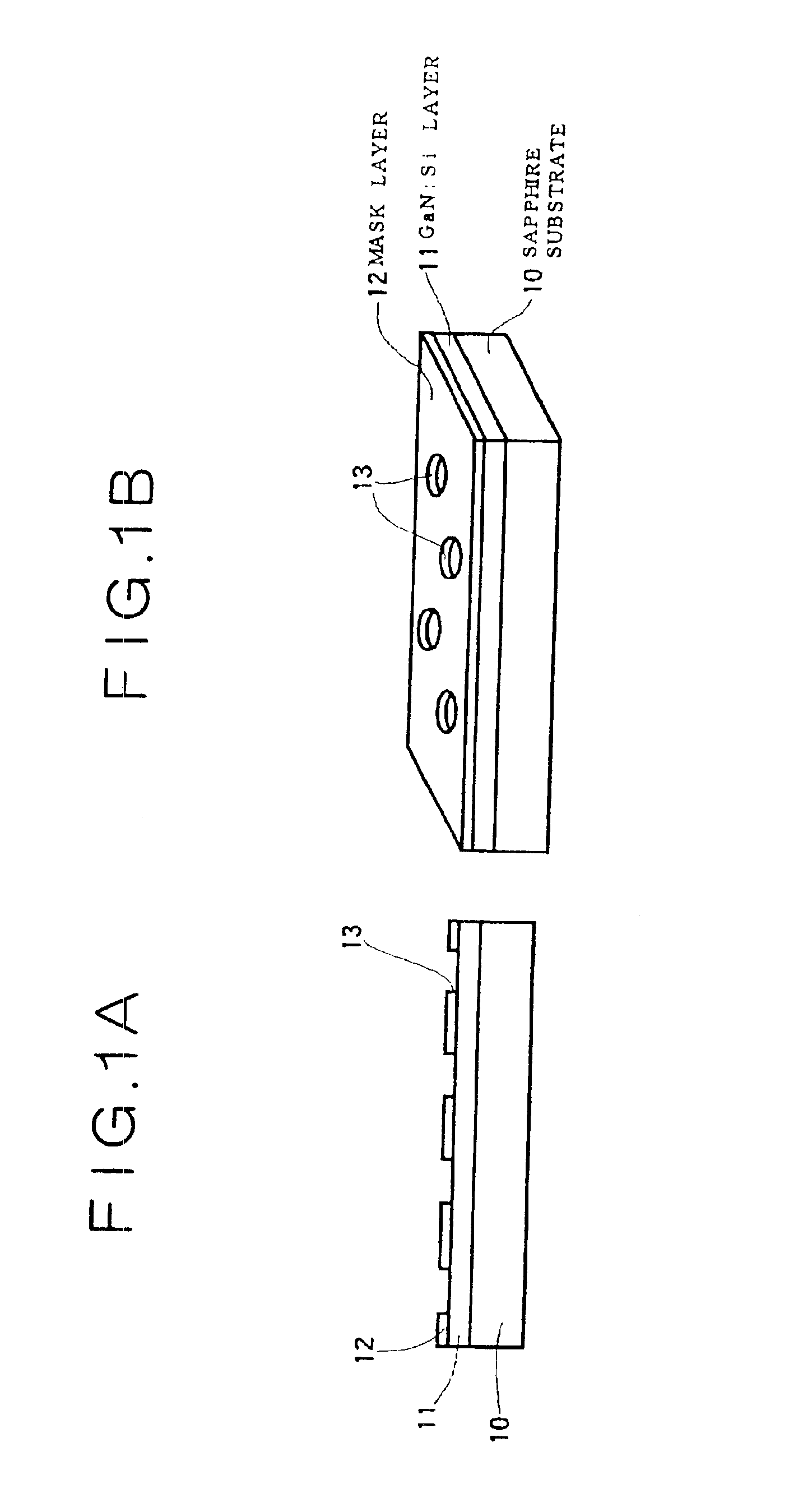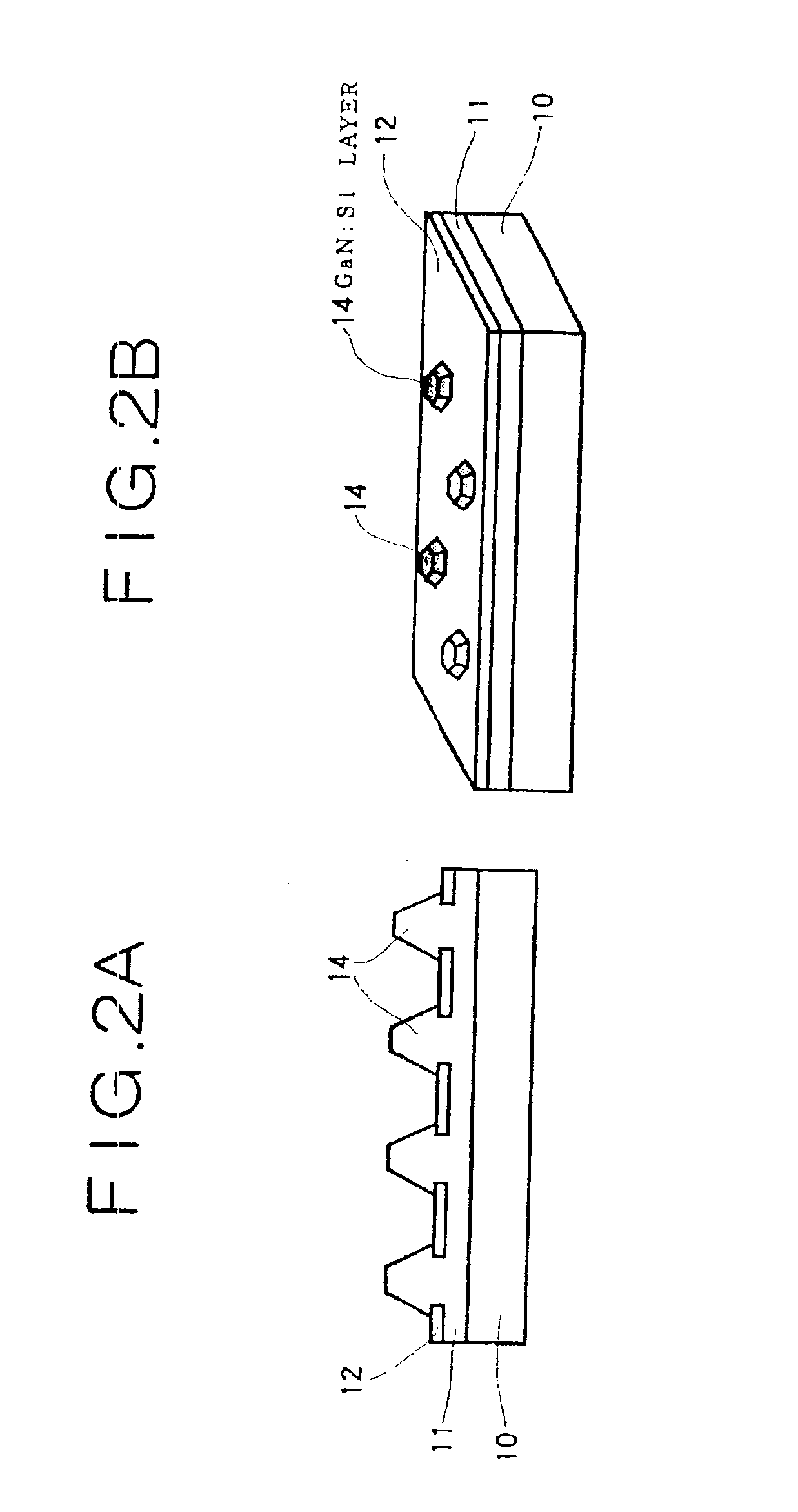Semiconductor light-emitting device and semiconductor light-emitting device
a technology of semiconductor light-emitting device and semiconductor light-emitting device, which is applied in the direction of semiconductor/solid-state device manufacturing, semiconductor devices, electrical devices, etc., can solve the problems of difficult to keep crystallinity at a high level, the inability to obtain good light-emitting characteristics, and the inability to form light-emitting elements in high precision
- Summary
- Abstract
- Description
- Claims
- Application Information
AI Technical Summary
Benefits of technology
Problems solved by technology
Method used
Image
Examples
example 1
[0111]This example deals with direct selective growth on a sapphire substrate wherein a selective crystal growth layer having different crystal planes including an S plane and a C plane, and regions of the S plane and regions of the C plane are divided from each other and independent p-electrodes corresponding to two color light-emitting wavelengths are formed. With reference to FIGS. 1 to 6, an element structure is described along with a fabrication process thereof.
[0112]First, a low temperature buffer layer made of either AlN or GaN is formed on a sapphire substrate 10 having a C+ plane as a principal plane thereof at a low temperature of 500° C. Thereafter, a mask layer 12 made of SiO2 or SiN is formed over the entire surface in a thickness ranging from 100 to 500 nm, and openings 13 with a size of approximately 10 μm are formed according to photolithography by use of a hydrofluoric acid etchant (FIG. 1). In this example, the opening 13 is substantially in a round shape, and the ...
example 2
[0122]This example is one which deals with direct selective growth on a sapphire substrate wherein a selective crystal growth layer having an S plane is formed and independent p-electrodes corresponding to two color light-emitting wavelengths are formed on the plane portion and the side portion of the S plane. Referring to FIGS. 7 to 12, the element structure is described along with its fabrication process.
[0123]First, a low temperature buffer layer made of either AlN or GaN is formed on a sapphire substrate 30 having a C+ plane as a substrate principal plane at a low temperature of 500° C. After raising to a temperature of 1000° C., a silicon-doped GaN layer 31 is formed. Subsequently, a mask layer 32 made of SiO2 or SiN is formed over the entire surface in a thickness ranging from 100 to 500 nm, and openings 33 with a size of approximately 10 μm are formed according to photolithography using a hydrofluoric acid etchant (FIG. 7). In this example, the opening 33 is substantially in ...
example 3
[0133]This example is one which deals with direct selective growth on a sapphire substrate wherein a selective crystal growth layer having an S plane is formed and independent p-electrodes corresponding to three color light-emitting wavelengths are formed. Referring to FIGS. 13 to 18, the element structure is described along with its fabrication process.
[0134]First, a low temperature buffer layer made of either AlN or GaN is formed on a sapphire substrate 50 having a C+ plane as a substrate principal plane thereof at a low temperature of 500° C. After raising to a temperature of 1000° C., a silicon-doped GaN layer 51 is formed. Subsequently, a mask layer 52 made of SiO2 or SiN is formed over the entire surface in a thickness ranging from 100 to 500 nm, and openings 53 with a size of approximately 10 μm are formed according to photolithography using a hydrofluoric acid etchant (FIG. 13). In this example, the opening 53 is substantially in a round shape, and the size may be changed de...
PUM
 Login to View More
Login to View More Abstract
Description
Claims
Application Information
 Login to View More
Login to View More - R&D
- Intellectual Property
- Life Sciences
- Materials
- Tech Scout
- Unparalleled Data Quality
- Higher Quality Content
- 60% Fewer Hallucinations
Browse by: Latest US Patents, China's latest patents, Technical Efficacy Thesaurus, Application Domain, Technology Topic, Popular Technical Reports.
© 2025 PatSnap. All rights reserved.Legal|Privacy policy|Modern Slavery Act Transparency Statement|Sitemap|About US| Contact US: help@patsnap.com



